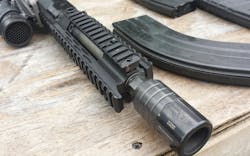Concussive force: the silent variable in hearing loss
Concussion--the silent variable in hearing damage
by Sean Bell
The U. S. Army Center for Health Promotion and Preventive Medicine lists hearing loss from gunfire as the most common injury for soldiers, and the Department of Veteran Affairs says hearing damage is the No. 1 disability claimed by returning vets. A ten-year study on police found that even with double ear protection, hearing loss still occurred in about 75 percent of those studied. It's not melodramatic or overblown to claim hearing loss is disabling some of our most brave men and women.
But why is hearing loss such a problem? Everyone who has ever taken a gun to a range either as a professional or amateur knows you need to wear ear protection. However, research is showing there could be more to protecting your hearing than just wearing the ear muffs or inserting the plugs (or both). Let's discuss just what hearing loss is and how it happens.
The intensity or volume of sound is measured in decibels (dB). Without going into too much detail of decibels, understand that a whisper is about 30 dB, normal conversation would be 60 dB, alarm clocks hit about 80 dB, and anything over 85 dB for an extend period of time can lead to permanent hearing damage. Over 140 dB for an impulse sound will do the same thing.
Almost all firearms (pistols, rifles, shotguns, etc...) start at 140 dB and can dramatically increase from there. This is why hearing protection is so important. From the first shot fired you are already at the threshold that causes permanent, irreparable hearing loss.
All standard hearing protective devices on the market have a Noise Reduction Rating (NRR). This number is not a one-to-one ratio; meaning a set of ear muffs with an NRR of 30 do not actually lower sound by 30 dB. You have to subtract 7 from the NRR and divide by 2. So a device with NRR 30 is actually only about a 12 dB deduction (30-7/2=11.5). If you are doubling up on both ear plugs and ear muffs, add 5 to the protection with the highest rating.
Now go grab whatever hearing protection you've been using. Do the math. Subtract that number from 140. Is it below 80? If not then you're damaging your hearing.
But wait you say, 140 dB is only for impact noises. I only shoot for a few minutes at a time, so my number is 80 dB.
Nice try, I say to you. If you're in an environment where shooting is happening (shooting range, military situation, etc...) then you need to count all the time you're there.
But here's the kicker, this is something few people are aware of.
Even if you get the best ear protection and then double up on both ear muffs and ear plugs, you still aren't stopping the hidden danger of hearing damage through bone conduction. This is the area where traditional protection completely fails you.
Sound can be transmitted directly through the bones in your skull into your inner ear. Regular protection doesn't stop this transmission of vibration and the skull only dampens between 40 db - 60 db of it. This type of damage is referred to as concussive damage and it is the secret culprit causing so much damage to military personal and law enforcement. Unlike the average shooter, military and law enforcement personnel are far more likely to be involved in close-quarters combat (CQC). This means the concussive force from their firearms poses a much greater risk because of the close proximity.
To give you an idea of how prevalent hearing damage is, 60 percent of veterans returning from Iraq and Afghanistan are suffering from hearing loss. This amounted to $1.1 billion in disability payments in 2011. It's not any better for police officers. In 2011 New York forced the retirement of police officers that wore hearing aids. Many of whom needed hearing aids because of hearing loss received while working on the job.
So how do we address this oversight in protection? Concussive damage is a little trickier to deal with than sound wave damage. Currently the best solution is a muzzle device. You want something specially designed to direct the concussive force of the shot away from the shooter and ideally force it parallel with the bullet. This means the sound and bullet are traveling in the same direction.
Understanding the different causes of hearing loss is the first step in keeping the men and women of our military forces and police personnel safe. The second is making sure they are equipped with the proper education and tools to protect themselves.
?“3 - The Effects of Hearing Protectors on Auditory Communications “ Retrieved from: http://solutions.3m.com/wps/portal/3M/en_US/3M-PPE-Safety-Solutions/Personal-Protective-Equipment/safety-management/safety-training/hearing-conservation-seminars/hearing-conservation-archives/?#section1
About the Author
Sean Bell
Sean Bellis a freelance writer living in Florida. He received his B.A. in Interpersonal and Organizational Communication from the University of Central Florida. He has held several educational leadership positions and works closely with the health and wellness industry. Questions can be sent to [email protected].
